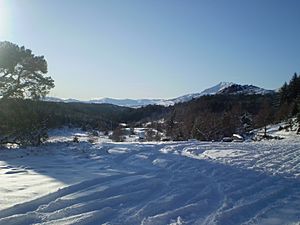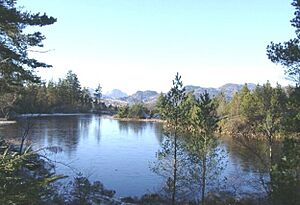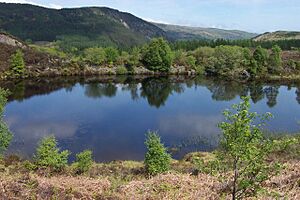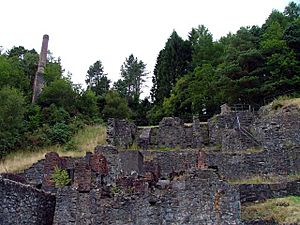Gwydir Forest facts for kids
Gwydir Forest, sometimes spelled Gwydyr, is a large forest in Wales. It's found in the Conwy county borough and inside the beautiful Snowdonia National Park. The forest gets its name from the old Gwydir Estate, which was once owned by the John Wynn family from Gwydir Castle.
Today, Natural Resources Wales helps manage the forest. They often use the spelling "Gwydyr Forest" or "Coedwig Gwydyr" (which means Gwydyr Forest in Welsh). People have known about this area for a very long time. Back in 1536, a writer named Leland said Gwydir was "a pretty place" near the River Conwy.
Contents
Exploring Gwydir Forest's Geography
Gwydir Forest pretty much surrounds the village of Betws-y-Coed. It stretches north to Trefriw village and south to Penmachno village. The forest covers a huge area, more than 72.5 square kilometers (about 28 square miles). About 49 square kilometers (19 square miles) of this is active woodland where trees are grown.
Thousands of years ago, natural trees grew on these hills. Later, in the 1700s and 1800s, people used to float timber down the River Conwy. They even shipped wood from the quay at Trefriw. In 1778, someone mentioned that the "noblest oaks in all Wales" once grew near Gwydir Uchaf.
The forest sits on a wavy plateau, like a high, uneven tableland. It's between 213 and 305 meters (700 and 1,000 feet) above sea level. Rivers like the Llugwy, Lledr, and Machno cut through this plateau. These rivers all flow into the River Conwy. Even though it's a forest, many parts are open, giving you amazing views of these valleys. You can also see the big mountains of the Glyderau, Carneddau, and even Snowdon itself!
The trees grow on the steep slopes and poorer soils. The best soil is saved for farming in the valley bottoms. Gwydir Forest gets a lot of rain, from under 127 cm (50 inches) to over 203 cm (80 inches) each year.
Lakes of Gwydir Forest
The forest is home to many lakes. You can reach all of them by walking on footpaths. Most of these lakes were actually made or made bigger to help the old mines in the forest. Here are some of the main lakes, listed by their size:
- Llyn Crafnant (about 25 hectares or 63 acres) – on the northern edge.
- Llyn Geirionydd (about 18 hectares or 45 acres).
- Llyn Elsi (about 11 hectares or 26 acres).
- Llyn Parc (about 9 hectares or 22 acres).
- Llyn Glangors (about 6 hectares or 15 acres).
- Llyn Bodgynydd (about 5.7 hectares or 14 acres).
- Llyn Goddionduon (about 4 hectares or 10 acres).
- Llyn Pencraig (about 2 hectares or 5 acres).
- Llyn Bychan (about 1.2 hectares or 3 acres).
- Llyn Sarnau (about 1.2 hectares or 3 acres).
- Llyn Tynymynydd (about 0.4 hectares or 1 acre).
There are also many smaller lakes that don't have names.

How Gwydir Forest is Managed
Gwydir Forest was officially started in 1921 by the Forestry Commission. This happened after the Forestry Act of 1919. Much of the land was bought from Lord Ancaster, whose family had inherited the old Wynn estate. The First World War showed that Britain didn't have enough wood. At that time, there wasn't much natural woodland left in the area.
Many of the first people who planted trees and worked in the forest had never done forestry before. They used to work in the mines that were in the forest. You can read many interesting stories from this time in a book called Tales from the Gwydyr Woods. Millions of young trees were grown in a nursery called Diosgydd. The first areas planted were those that already had some trees. Most of these original tree plantations have now been cut down and replanted as part of the forest's ongoing cycle.
Types of Trees in Gwydir Forest
Most of the trees in Gwydir Forest are conifers. These are trees like Sitka spruce, Douglas fir, Japanese larch, Norway spruce, and Scots pine. Conifers grow well in the poor, shallow soils of the area. However, in recent years, more native broadleaf trees have been planted. These include Welsh Oak, beech, and ash.
Broadleaf trees are planted to make the forest look more varied and natural. They help soften the straight lines that conifers can create. But growing faster-growing conifers is still important for business reasons. Conifers can be planted and harvested in 20 to 40 years. Oak trees, on the other hand, take almost a century to grow big enough!
The forest still provides jobs for about 75 people directly. It also creates work for many others in the local area. It's estimated that the forest grows about 125 tons of wood every day. The same amount is harvested to be used. Sometimes, paths in the forest might be closed if forestry work is happening. You can call the Forest Office at Gwydir Uchaf (01492 640578) for more information. This building was built by Sir John Wynn in 1604.
Fun Activities in Gwydir Forest
Snowdonia National Park owns about 12% of the land managed by Natural Resources Wales. Out of the four main forest areas, Gwydir Forest is probably the most popular for visitors. In 1937, Gwydir was named a National Forest Park. Since 1993, the main part of the forest has been given the special title of Forest Park. Making it a fun place for visitors has been a big part of this plan.
The forest is easy to explore. It has wide tracks, old paths used by miners, and well-known forest walks. Many of these walks have signs to guide you. The forest has become even more popular recently because of the Marin Trail. This is a special mountain bike route that's about 28 kilometers (17 miles) long. It has 860 meters (2,820 feet) of climbing, making it a challenge for mountain bikers!
Forest workers need to drive their vehicles on the forest roads. There are over 160 kilometers (100 miles) of roads and tracks in the forest. However, private cars are usually not allowed, except on special "Open Days." But don't worry, there are several car parks in the forest, and most of them have picnic areas where you can enjoy a meal outdoors. The forest was even used as a special stage for the 2013 Wales Rally GB car race.
The Old Mines of Gwydir Forest
Today, as you walk through the forest, you'll see the remains of old metal mines. These include old engine houses, piles of waste rock, reservoirs, and the openings of the mines themselves. But this is just the surface! Below ground, there's a huge maze of tunnels, stretching for many miles. Miners mainly dug for lead and zinc. The busiest time for metal mining in the forest was between 1850 and 1919. However, mining on a smaller scale started as early as the 1600s. It's even possible that the Romans did some shallow mining here, as the Roman road of Sarn Helen passed through the forest.
The most important mines were:
- Parc Mine
- Hafna Mine
- Llanrwst Mine
- Cyffty Mine
- Pandora Mine
- Aberllyn Mine
These mines are located in the central part of the forest, in an area called Nant Bwlch-yr-haearn.
Parc Mine was the biggest and most successful of these mines. It opened in 1855 and was worked on and off until the 1940s. By World War II, it was the only mine still working. It reopened in 1950 and produced more lead and zinc ore between 1953 and 1957 than the whole Llanrwst area had in the previous century! Even with some modern updates, it closed around 1960.
The first four mines listed above are connected by the "Miners Trail." This is a circular walking route with information boards to teach you about the mines. You can also easily see their remains from the road that goes from Gwydir Castle (on the B5106 road) through Nant Bwlch-yr-haearn to the Ugly House on the A5 road.
Remember those lakes we talked about? In this central mining area, almost all of them were created or made bigger to store water for the mines. In most cases, water flowed from these lakes through channels called "leats." This water then turned water-wheels, which powered the machinery at the mine sites.
When the Forestry Commission bought the land, they worked to make the old mine workings safe. Before more people started visiting, even more safety work was done. This was helped by the National Park Authority, the Welsh Development Agency, and other groups like the Countryside Council for Wales, the Welsh Mines Society, and Gwynedd Archaeological Trust. There are so many tunnels underground! People hope that some safe areas might be opened for limited visits in the future.
Many books have been written about these mines, especially a series of 7 books called Mines of the Gwydyr Forest.
Rare Plants and Animals in Gwydir Forest
The piles of rock waste left over from the old mine sites have become perfect places for rare plants to grow. Because of this, part of the forest has been named a Site of Special Scientific Interest (SSSI). This means it's a very important place for nature. These special plants are called metallophytes. They are only found around old metal workings. They can take minerals from the rock that would kill other types of plants. Some of the main metallophytes found at the Gwydir mine sites are pennycress and forked spleenwort.
Bat Habitats in Gwydir Forest
When the mine shafts were closed off for safety, they created an ideal environment for bats. This led to the area being named a Special Area of Conservation (SAC). In February 2001, a lesser horseshoe bat (Rhinolophus hipposideros) was found sleeping in an old mine in the forest. This was the furthest north in the UK that this type of bat had ever been found! The bat had been tagged as a young bat in 1999 in the Forest of Dean, showing how far it had traveled.
Pine Martens in Gwydir Forest
Even though there aren't many photos, over 100 sightings of pine martens have been reported in north Wales in the last ten years. In 1996, scientists even found pine marten DNA in a dropping found in Gwydir Forest. This shows that these rare animals are living there.
|







